Directing by its very nature is a collaborative game. Your success hinges on your ability to steer your creative dream team towards realizing your vision. So what happens when your main collaborator happens to be one of the world’s biggest pop superstars? How do you steer a force of nature? Three of the directors behind Beyoncé’s 2013 visual album gathered at the 2014 Los Angeles Film Festival earlier this summer alongside James Sabey, Head of Worldwide Marketing at Parkwood Entertainment (which released the record along with Columbia) to share their behind-the-scenes tales of working with Queen B on what started out as a secret project and would come to be her fifth consecutive number-one album, the fastest-selling album in iTunes history, and a massive worldwide hit, topping 3.3 million in sales. “The project began as a visual project for Beyoncé,” said Sabey. “She really does see music when she’s in studio. We started talking about what was interesting visually in each song, what was the theme and what was the thought process, and who was the writer, and she really wanted to develop this record as a visual project, and so the directors were incredibly important from the beginning of the process. We threw the doors wide open and started to talk with a lot of people Beyoncéhas worked with in the past, people we thought would challenge her visually and do things she’s never done before. Everything she does comes from a place of wanting to challenge herself artistically. So we really did look for directors who had ideas, were looking to collaborate, who would listen to songs and come up with new ways of presenting them.” Working with a time-crunched timeline is typical for music videos, but for Jake Nava, who directed three of the songs on the album (Partition, Flawless and Grown Woman), there was the added stress of having to shoehorn his shoot into the jammed schedules of two megastars; one of the scenes in Partition has Jay-Z with Beyoncé in the back of a car. “There was going to be romantic vibe,” Nava explained. “I was keen to capture the magic of the intimacy between them.” But the car scene came after the dance scene, which took longer than expected. “She’s a perfectionist and she doesn’t have a lot of rehearsal time these days,” Nava explained. “So we ended up polishing on set, even when she assures me that’s not going to happen.” The time it took to nail the dance scene put them in a tighter time crunch for the scene with Jay-Z. “We did that scene in very few minutes, 10 or 15, and by then was a police escort waiting to take him to the heliport in Paris to get him to his own concert that night [in London.] It was quite funny to watch her pushing him because she wanted him to stay and make her video better, but he had to go, and she was like ‘Just one more.’”
Time turned out to be an even more formidable the enemy for Melina Matsoukas, who directed Pretty Hurts, and confessed it was the most challenging shoot she’d ever had. “My crew quit,” she said, “and Harvey Keitel almost murdered me.” The set-up took longer than anyone expected, Matsoukas explained and the crew decided they were about to bail just when it was time to shoot Keitel’s close-up. “Harvey Keitel graciously stayed the whole day. He’s there because he’s an amazing actor and he wants to be part of the project, and he had been waiting 20 hours, and I told him we would shoot his close-up and my producer comes by and says, ‘We’re gong to have to move on to the next setup. The crew’s going to leave in the next five minutes so you have to move on.’ So after promising Harvey we were gong to shoot his close-up, we’re going to move onto the next set-up. He was like, ‘Me and you are having a miscommunication. This is not working for me.’” She told him ‘You’re right. We’re going to shoot your close-up.’ Beyonce looked at me, and I said, ‘You can tell him [we’re not shooting him] I’m not gonna tell him… I’m not gonna end up in a hole somewhere.’ And we shot his close-up and I didn’t yell ‘cut’ and we went right into the next scene. And then everybody quit.” (They shot pick-up the next day with a smaller crew.) Nava was the natural choice to field a question about the overt sexuality in some of the video storylines. “I’ve been working with her since Crazy in Love and I’ve grown used to filming her in sexualized situations and continue to see her evolve, and make it feel more engaging and new for her and new for you each time. She’s very comfortable with her sexuality. Why wouldnt she be? On this album she was more ready to be overt. I noticed that having had the baby, she was ready to make it clear that she was still beyond comfortable. She was feeling like making it clear, I think, that becoming a mom doesn’t make you less hot.” Pamela Miller / Website & Grants Manager
